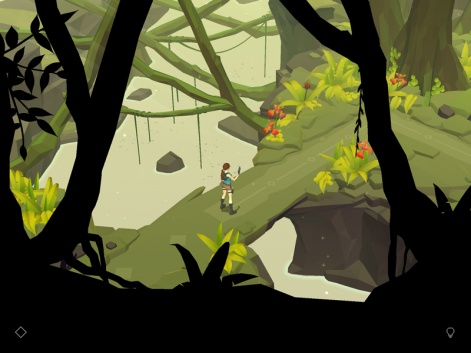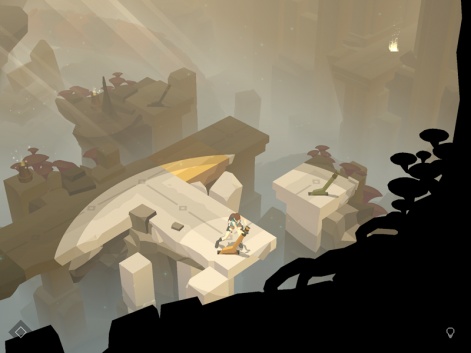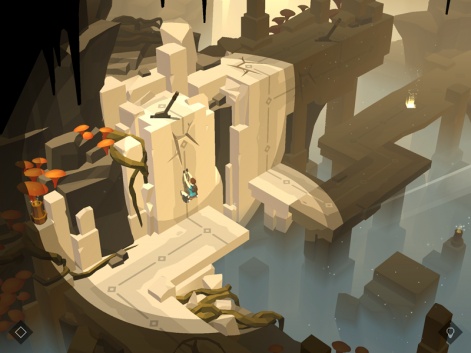With a shiny 9/10 and Pocket Gamer gold award tucked under its utility belt, Lara Croft GO turned heads here at PG HQ.
The turn-based puzzler is the spiritual successor to 2014's Hitman GO, taking the essential ingredients of its console cousin and mixing them into a brand new mobile cake.
Square Enix whipped the cloak off Lara Croft GO at E£ 2015. Adorned with a $4.99 premium price tag, the game made waves thanks to its streamlined mechanics and beautiful art style.
We caught up with Antoine Routon, Lara Croft GO's lead engineer at the company's Montreal studio, to delve deeper into the making of process behind the game and uncover some of the development team's secrets.
PocketGamer.biz: Why did you decide to make a Lara Croft themed 'GO' game?
Antoine Routon: Square Enix Montreal was founded three years ago. At first our mandate was to create a triple-A Hitman game. After a few months of development, Square Enix realized that there were no studios creating mobile games within the group, even though it's a booming market. So the decision was made to re-purpose our studio.
This was followed by a period of incubation and game-jams, were Daniel Lutz, the game director on both GO games, and myself came up with the idea of Hitman GO: a boiled down take on Hitman's universe, specifically designed for mobile.
We wanted to focus on Lara versus a hostile environment, rather than her fighting goons.Antoine Routon
This was an unexpected concept which eventually paid off, as the game was very well received.
When we saw the success of Hitman GO, we looked at how we could create more of this concept that people liked. And there was Lara Croft, one of the most iconic video game character ever, and heroine of our childhood.
It didn't take us long to put two and two together …
When it was decided to add a follow up to Hitman GO, what was your starting inspiration in terms of matching Hitman's success, yet creating a game with fresh twists?
We knew almost right away that we didn't want to do "just" a sequel. The world of Agent 47 and the world of Lara Croft are vastly different, and we had to make radical changes so that Lara Croft GO stood in its own right. Hitman GO was praised because it really "felt like Hitman", and rather than spraying some Tomb Raider paint on it, our goal was to make a true Lara Croft adventure.
One of the first things we changed was animation: Lara Croft is athletic and acrobatics are an important part of the franchise, so we knew that she had to be animated.

Once we made this decision, the board game aesthetics started to make less sense. But that was okay, because the clinical look of these diorama-meets-chess levels made more sense for Agent 47 anyway. So we got rid of that as well.
Then we removed the human enemies, as we wanted to focus on Lara versus a hostile environment, rather than her fighting goons.
We're really careful about crafting experiences specifically for the device we're working with.Antoine Routon
The way we laid out levels changed as well: Hitman GO provides a seemingly endless sequence of contracts around the world, Lara Croft GO is very much a story, with a beginning, a middle and an end.
And on and on, we stripped the project of everything that didn’t fit with the Tomb Raider universe. In the end, there are huge differences between the two games; the main link that remains is the core turn-based mechanics.
What were the key Tomb Raider ingredients you wanted to bring to mobile?
It was a really fun process to see how we could translate all the Tomb Raider tropes in terms of turn-based puzzles.
I already mentioned how adding animation was a pivotal moment for us, but once we got started we couldn't stop. To emphasise even more the athletic nature of Lara, we started to add random variations in her movement: when she climbs a wall there is a chance her hand will slip for a few seconds, when she climbs a ledge she might do the iconic handstand from the old Tomb Raider.
Eugene Jarvis, our animator, did an amazing job at capturing the way Lara moves in her previous adventures, while keeping the animations fast enough to work well with the puzzle format.

Beside acrobatics, combat and exploration are major pillars of any Tomb Raider adventure. For combat, we kept the simple mechanic established in Hitman GO, but combining it with the new animation system gave it a whole new shine.
Regarding exploration, we used a “follow” camera: in Hitman GO, you can peak around in a very voyeur way - very Hitman - but with Lara Croft GO, the camera follows Lara, and you discover the environment with her, as she explores.
Both Hitman and Lara Croft could have seen life on mobile as direct ports with virtual joysticks - do you think these iterations would have been as successful?
One might think it would be respectful of the brand to make an exact copy of Lara's adventures as they exist on consoles; with camera in thirdperson, intense action sequences, virtual joysticks, etc. But the result would disappoint: "gamers" would rather play such a game on console, mobile and casual players would find it too complex to play.
That's why we're really careful about crafting experiences specifically for the device we're working with. We're not trying to replicate exactly what has been done on console, but rather to create our own space and offer a complementary entry point to the franchise.
You mention controls, and of course this is one of the first differences that come to mind. But the way games are consumed on mobile is also very different: shorter but more frequent sessions, which require more immediate gameplay, and a progression that can easily be left off and resumed later. When we design GO games, all these constraints are at the heart of our reflections.
This is the cool thing about Square Enix Montréal: we’re creating our own space, at the intersection between existing triple-A universes and more compact games designed for mobile.
How big is the Square Enix Montreal team and how did you work together during the creation process?
The team on Lara Croft GO was 10 people on average, starting around 5 in pre-production, and going up to 15 for the last stretch.
Working on a Lara Croft game is a child’s dream, but it’s also a lot of responsibility.Antoine Routon
Initially there is high-level vision, but this is just a loose framework that constantly evolves. To really flesh out the game, we need ideas. And everybody in the team has ideas, so we try, we discuss, we discard the ones that don’t work and refine the ones that do.
It’s an extremely iterative process, which also modifies what we thought the game was going to be. In a way, the game reveals itself to us.
What is your favourite level of the game and why?
I really like the “Canyon of a Thousand Snakes”, in the Maze of Snakes. I like how Lara is progressing along this steep cliff.
At the beginning, you can see the second puzzle from the first if you peek through the trees. The little grotto for the third puzzle is pretty cool too, bringing you inside the mountain before you end on top it.
In one level, you really feel like you’re traversing this environment and not “just” solving puzzles. It’s also the first level to introduce the spear, which is one of the fundamental mechanics of our game.
How did you go about crafting the game’s visual aesthetics?
We were inspired by the very first Tomb Raider, from 20 years ago. Back then, the PlayStation 1 could not display a lot of polygons, and the "low-poly" style of the first instalment in the series was actually a technical constraint! Everything was very cubic and faces were very large.

Daniel Lutz, our game director, started to wonder: what if we could make the cool 2015 version of this low-poly style? We started to experiment with this, and this is how the visual direction of Lara Croft GO emerged.
How important is sound to Lara Croft GO?
We see Lara Croft GO as an experience. Visuals are important but audio is just as essential, and this was a great medium to give a different take on what you might expect from a Lara Croft game.
Also, because this is a puzzle game, we knew we wanted something more atmospheric that wouldn’t impede your capacity to think.
With all these constraints in mind, we worked hard with Pixel Audio, a small studio in Montréal… and I think we found a mix that works pretty well!
What were the main development tools you used?
We’re using Unity and we’re very happy about it: it allows us to focus on making games rather than spending time on building an engine that works across all mobile environments.
What were the main challenges you encountered during development, and how did you overcome them?
Working on a Lara Croft game is a child’s dream, but it’s also a lot of responsibility. We wanted to come up with a fresh new take on Lara's adventures, but it was also important for us to respect the existing universe and the very rich body of work established in more than 15 games spanning over 20 years.
Crystal Dynamics - Tomb Raider's brand owners – were very helpful in helping us understanding the license. Lara’s outfits we offer in game are the perfect example: with the help of the Community Manager at Crystal Dynamics, we have been able to choose the most popular outfits, to make sure we please the fans!
What plans do you have for the franchise moving forward?
We’re exploring different avenues. We have released three games in two years, and this is only the beginning.
What is certain is that aim at delivering mobile games of the highest quality. That's a lot of work, but it is an amazing mandate!





















